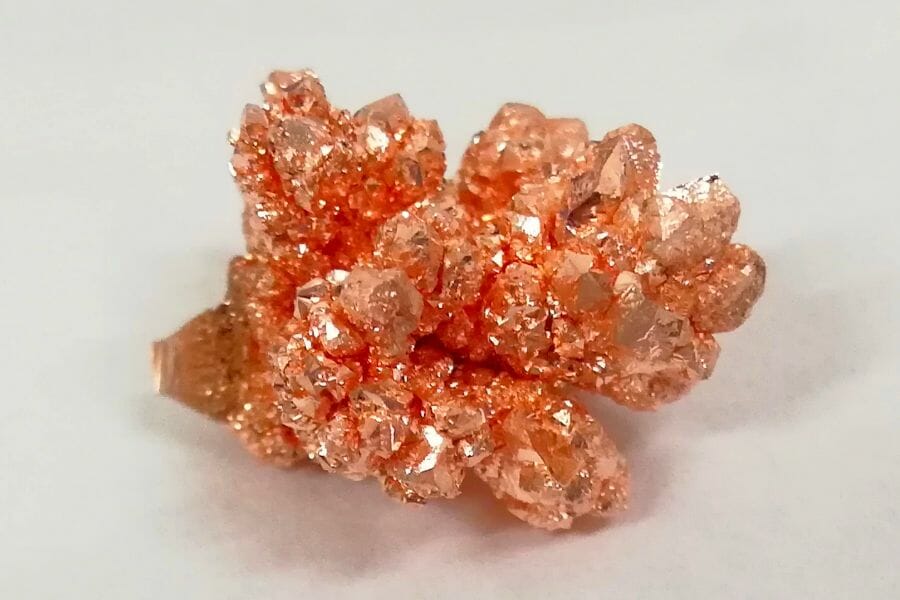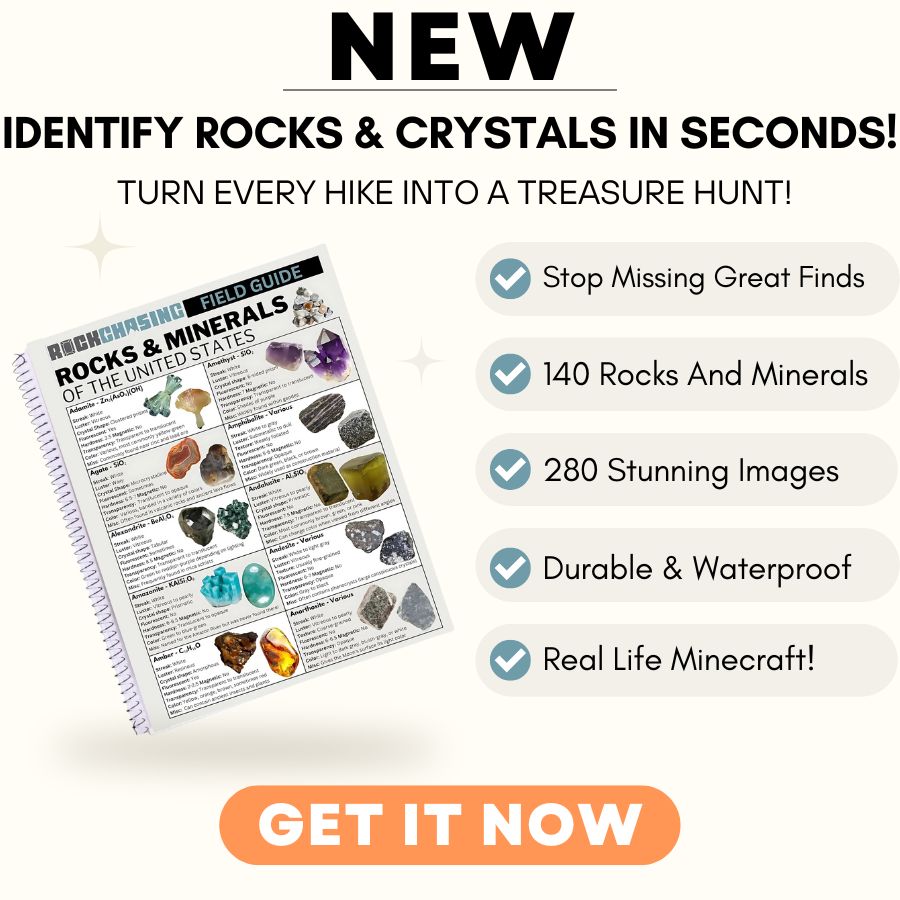Finding crystals can be a rewarding adventure, offering a unique way to explore the natural beauty and geology of the region. Whether you’re a seasoned rockhound or just getting started, knowing where to look is key to uncovering these hidden treasures.
In this state, a variety of locations provide opportunities to discover different types of crystals. From rocky outcrops in the mountains to stream beds that carry sparkling surprises, each area offers its own unique finds for those willing to search.
We can help you get started with some places you can explore for crystals below!
Crystals you can find in the US
The United States offers a wide range of crystals that reflect its diverse geology. From vibrant gems to more subtle mineral formations, there’s something to discover in nearly every region.
Calcite
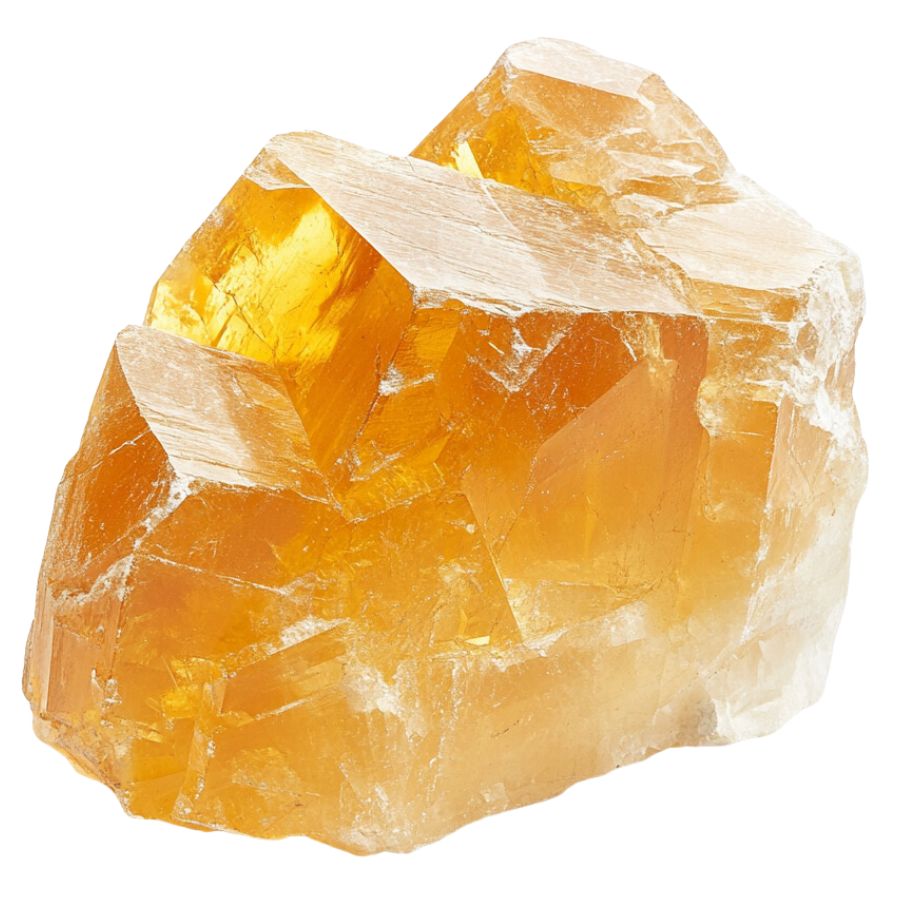
With a variety of forms and a unique property of double refraction, calcite allows objects viewed through the crystal to appear doubled. This mineral can appear in a spectrum of colors, with pure forms typically being transparent or white.
In addition, calcite reacts vigorously with acids, which aids in distinguishing it from other minerals. It also frequently contributes to the structure of sedimentary rocks such as limestone.
Gypsum
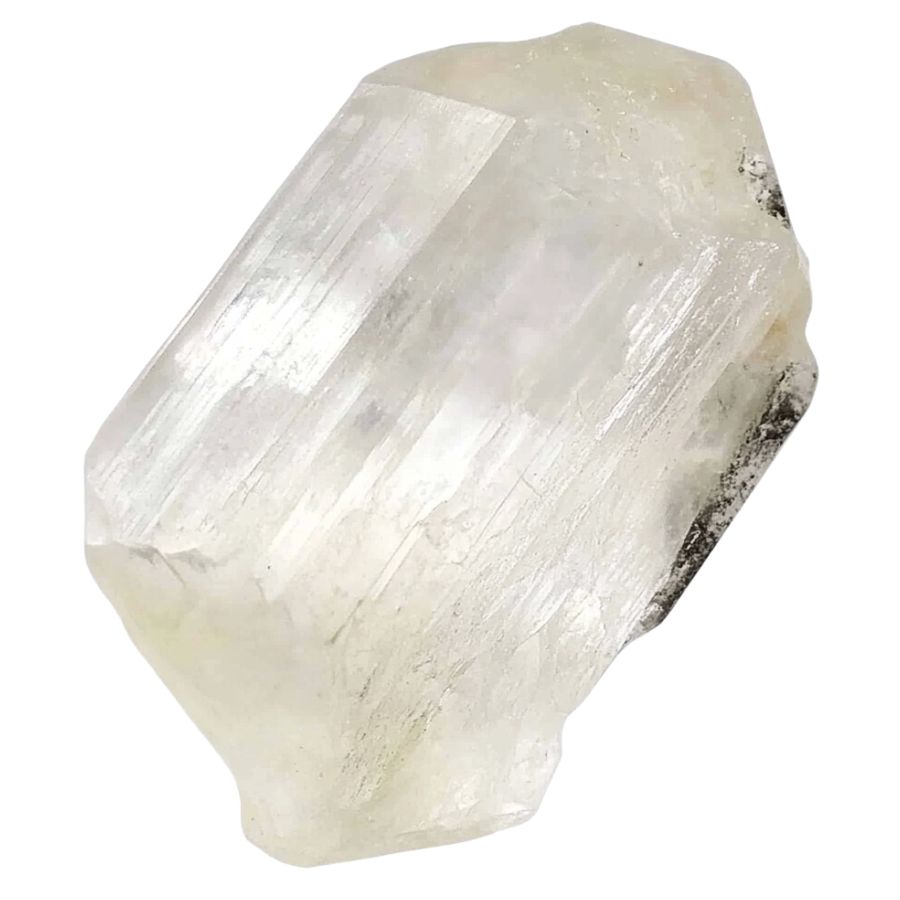
Gypsum’s notable softness allows it to be easily scratched with just a fingernail, often presenting as white or very light-colored in its pure form.
It manifests in both crystalline forms, like selenite, and massive forms such as alabaster, making it versatile in use and appearance.
Gypsum is also essential in the construction industry and is a key component in the manufacture of plaster and drywall.
Fluorite
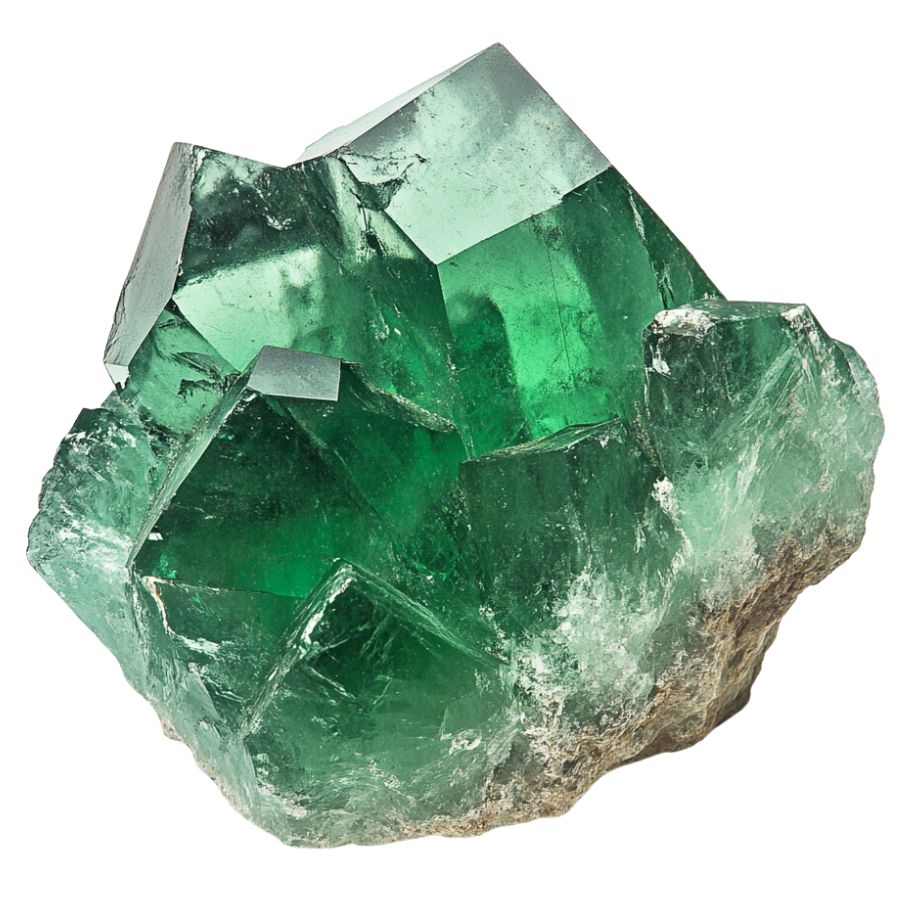
Fluorite comes in a wide range of vibrant colors, including purples, greens, blues, and yellows, and is known for forming in well-defined cubic crystals.
Beyond this, fluorite exhibits fluorescence under ultraviolet light! It can also be used in various industrial applications, including as a flux in steelmaking.
Galena
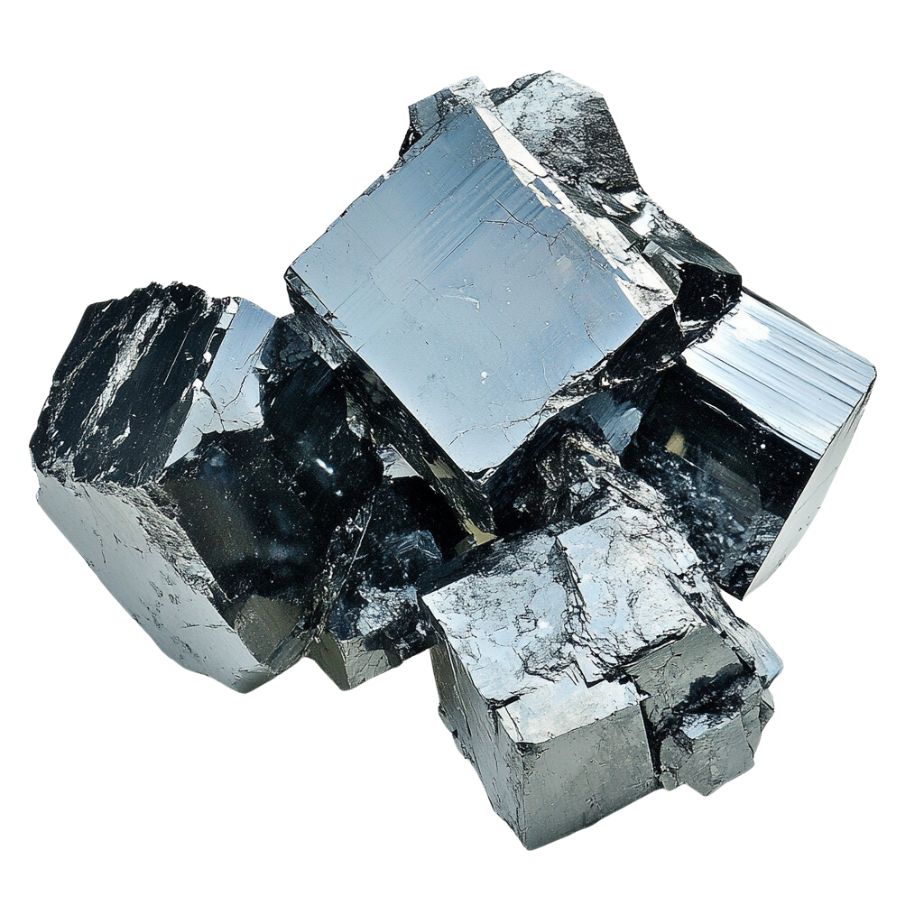
Galena distinguishes itself with a metallic luster and high density, typically found in a cube-like form. It serves as the primary ore of lead, making it important in the metal industry, while its shiny, silver color attracts collectors.
Not only does its appearance make it a subject of interest, but its weight and texture provide tangible lessons in mineral density and metallic properties. Galena also often contains traces of silver, adding to its commercial and educational value.
Corundum
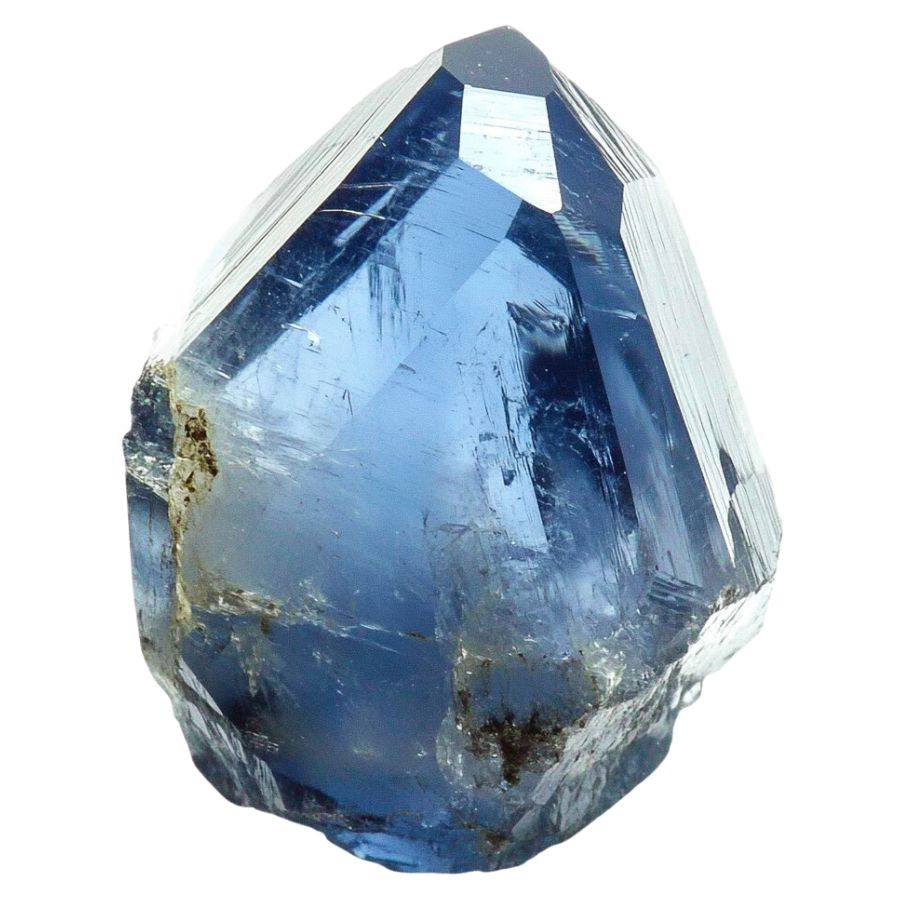
Corundum is a mineral that comes in a variety of colors, though it is typically transparent or gray. Its most famous forms are sapphires and rubies, which are prized for their vibrant blue and red hues.
The mineral is known for its remarkable hardness, ranking just below diamond on the Mohs scale. This durability makes corundum ideal for industrial abrasives and cutting tools, as well as a popular choice for fine jewelry.
Quartz
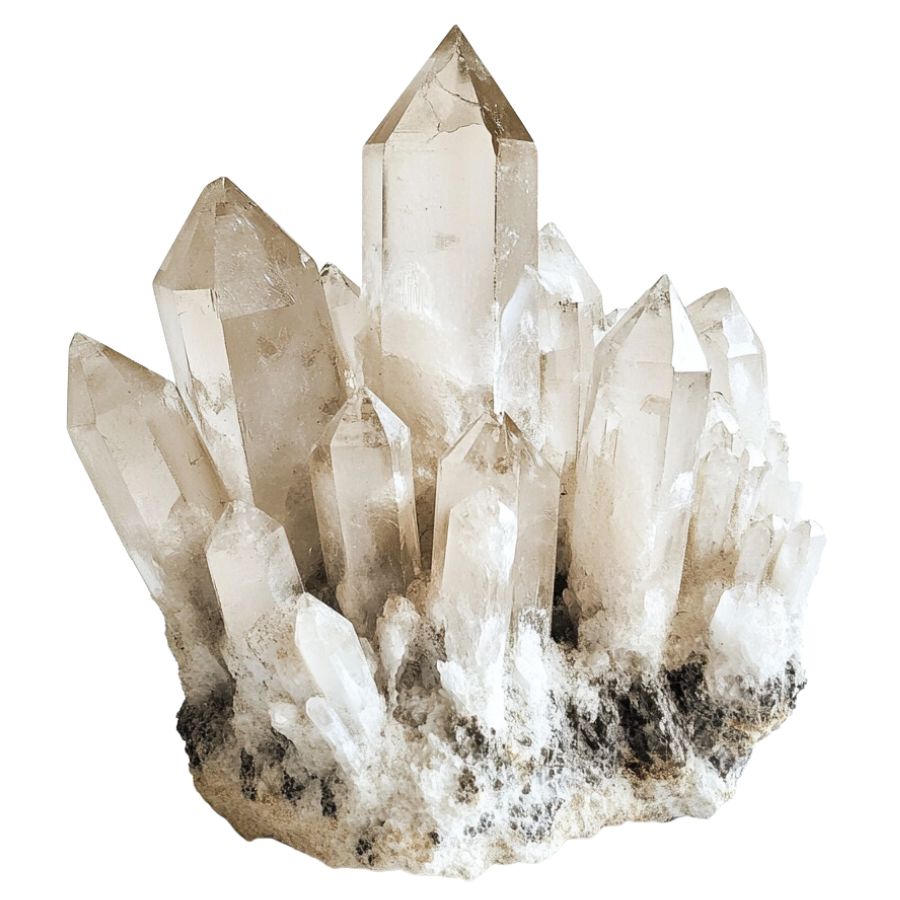
Quartz is among the most common minerals in the Earth’s crust and is prized for its durability and variety. It forms in a wide range of colors and types, from clear rock crystal to purple amethyst.
The mineral is notable for its hardness and durability, which contribute to its use in a variety of applications. Quartz is also popular in the manufacturing of electronics and watches due to its piezoelectric properties, which allow it to convert mechanical pressure into electrical energy.
Pyrite
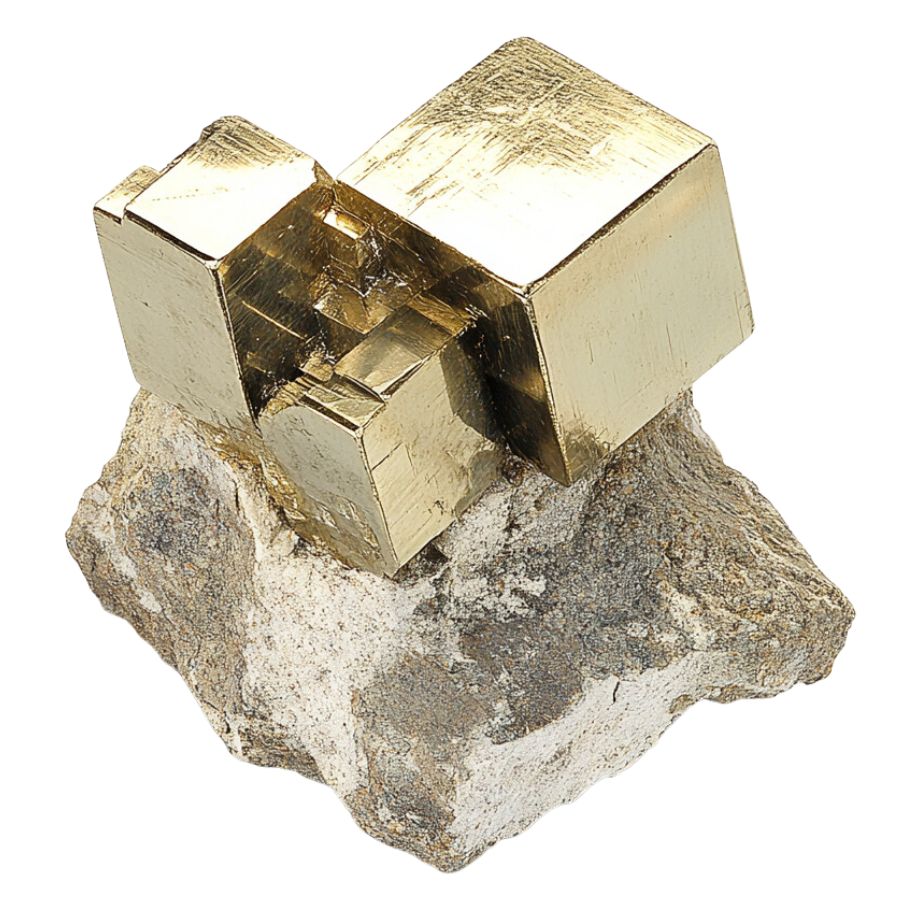
Often mistaken for gold due to its metallic luster and pale brass-yellow hue, pyrite is known colloquially as “fool’s gold.” Its characteristic cube-shaped crystal formations look man-made but are actually completely naturally formed!
Pyrite also has historical importance in producing sulfur dioxide for sulfuric acid production.
Rhodochrosite
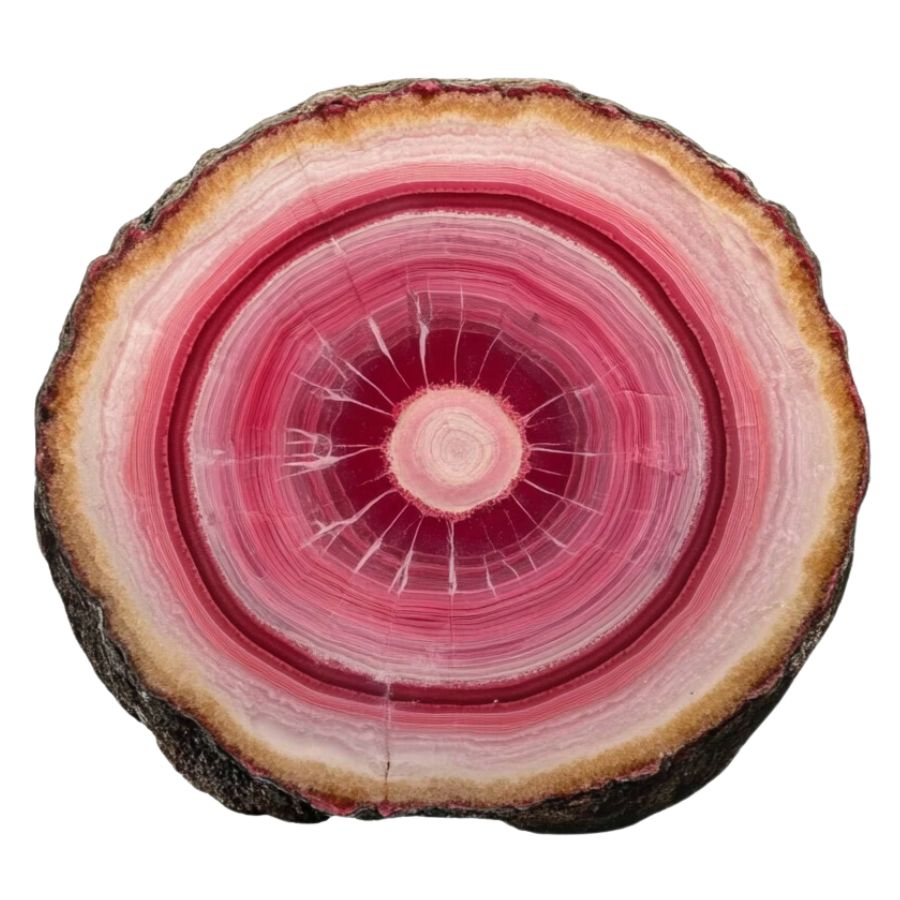
Rhodochrosite stands out with its rich pink and red hues, making it highly desirable as both a mineral specimen and a gemstone.
It typically forms in layered or stalactitic structures, with bands of colors that showcase how it grew over millions of years.
Beyond its beauty, rhodochrosite is significant as the main source of manganese, an essential element used in metal alloys.
Rhodonite
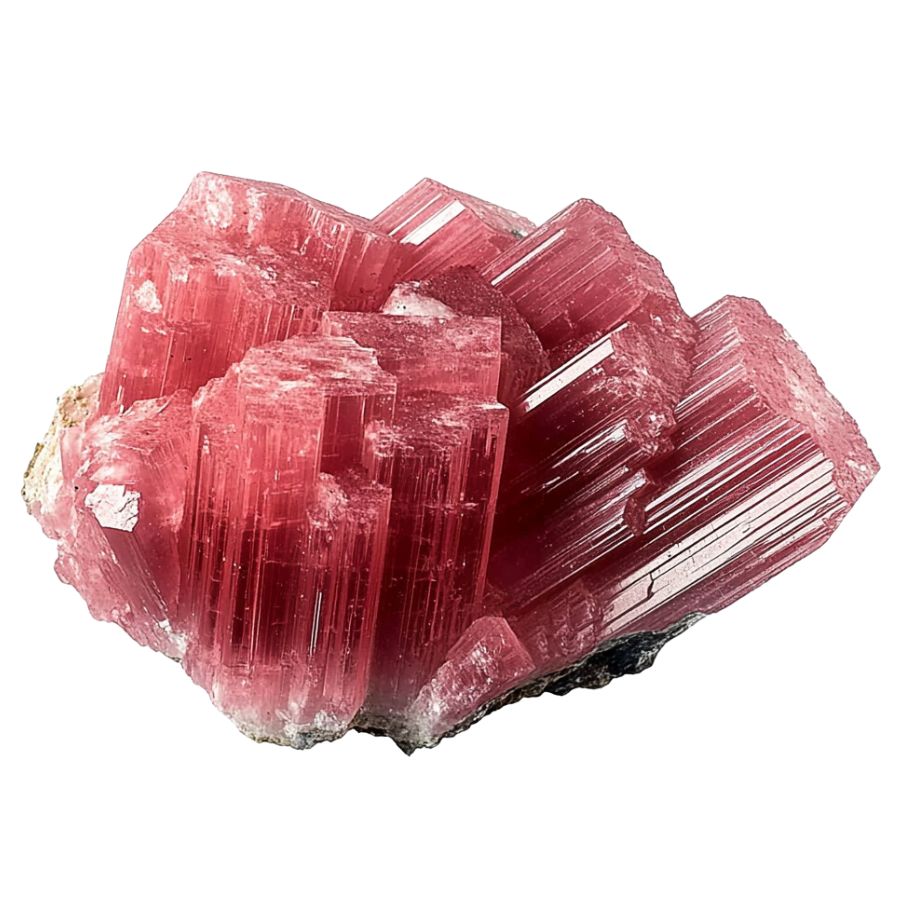
Appreciated for its deep pinks and reds, often complemented by black manganese oxide veins, rhodonite presents a dramatic appearance. It is typically found in metamorphic rocks and is used both as an ornamental stone and in jewelry.
In geology, rhodonite is significant for its role in metamorphic processes and its association with other manganese-rich minerals. It can be found in metamorphosed sedimentary rocks and is sometimes used as an indicator of the presence of manganese deposits.
Vivianite
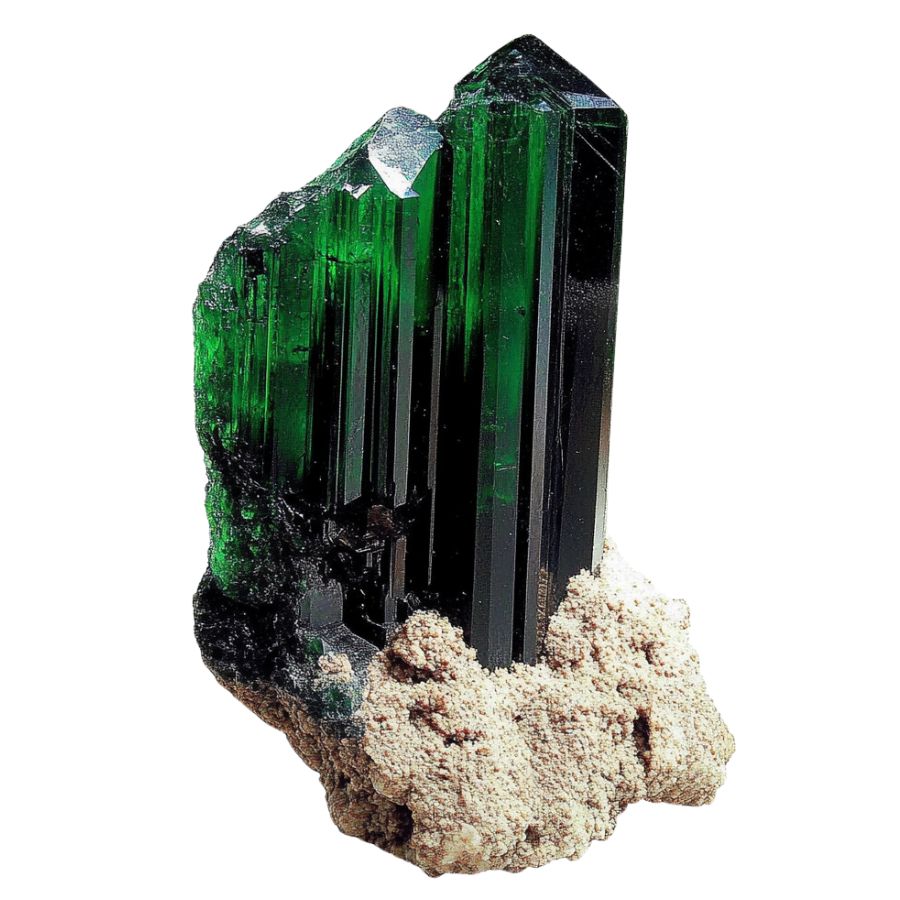
Vivianite, an iron phosphate mineral, emerges in low-oxygen environments like peat bogs or iron-rich deposits. Its striking blue to green color, which can change to a lighter shade over time due to oxidation, makes it a distinctive mineral.
Found in various geological settings, vivianite provides clues about the local conditions and the presence of phosphate deposits.
The Types of Michigan Crystals You Can Find
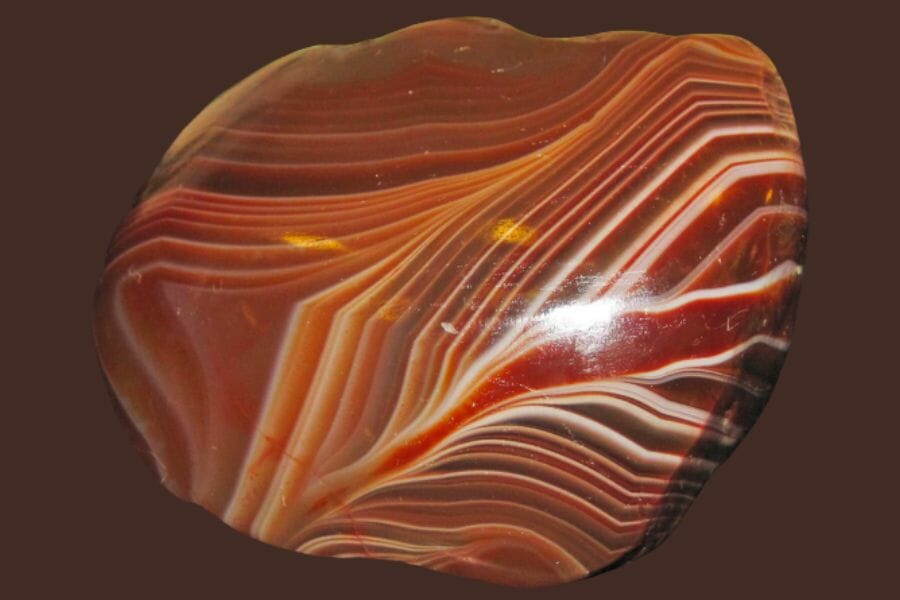
Here in Michigan, you can find a wide variety of stunning crystals that are highly prized by collectors and enthusiasts. What makes Michigan crystals so special is their incredible beauty and diversity.
Whether you’re looking for the perfect addition to your collection or just want to marvel at the wonders of the natural world, these crystals are sure to capture your imagination and leave you in awe of their beauty. There are many different types of rocks found in Michigan and a lot of them are pretty spectacular.
Rare crystals found in Michigan
- Agate (Lake Superior Agate)
- Carnelian
- Copper
- Garnet
- Sapphire
- Septarian nodules
More common crystals found here
- Amethyst
- Azurite
- Calcite
- Chalcedony
- Chalcopyrite
- Chrysocolla
- Celestite
- Epidote
- Fluorite
- Jasper
- Hematite
- Malachite
- Onyx
- Prehnite
- Pyrite
- Quartz
- Rhodochrosite
- Tourmaline
What rough crystals look like
When you’re out looking for crystals on your own it’s important to know what you’re looking for. This is what you need to look out for:
Look for exteriors like this
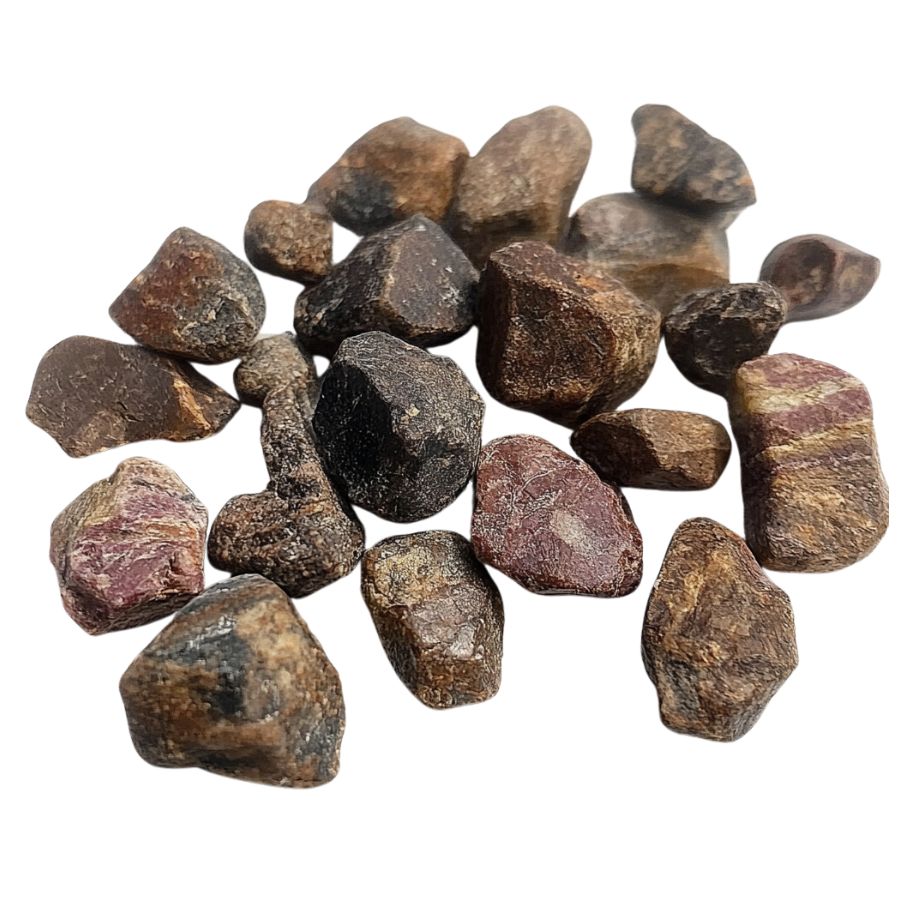
When you’re out searching for crystals in the wild, it’s essential to keep in mind that what you find won’t look like the polished stones you see in stores. One important tip is to consider what certain crystals look like in their raw, natural form.
Without the shine and smooth finish, crystals might appear rough, with jagged edges or earthy tones masking their true beauty. Understanding this can help you spot potential finds that might otherwise be overlooked.
Examine the crystal structure and shape
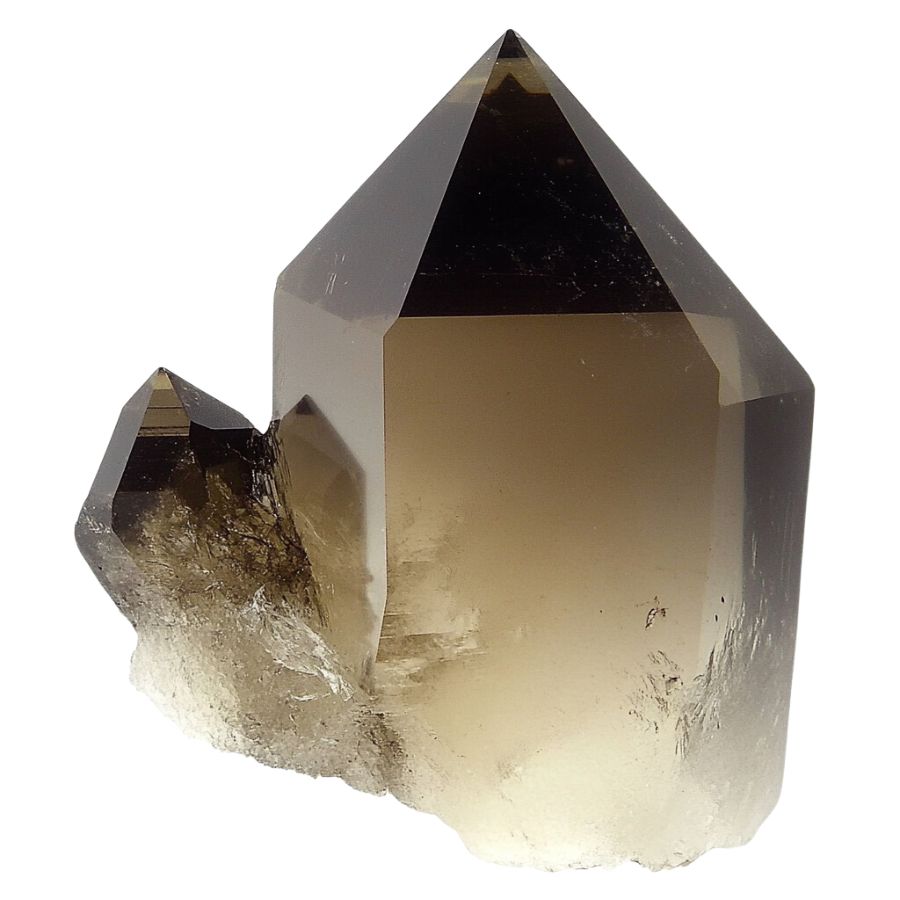
Crystals often form in specific geometric patterns that can be key to identifying them. For example, quartz is known for its hexagonal prisms, while halite typically forms cubic shapes.
By recognizing these distinct patterns, you can differentiate between various types of crystals and better understand what you’ve found.
Observe color
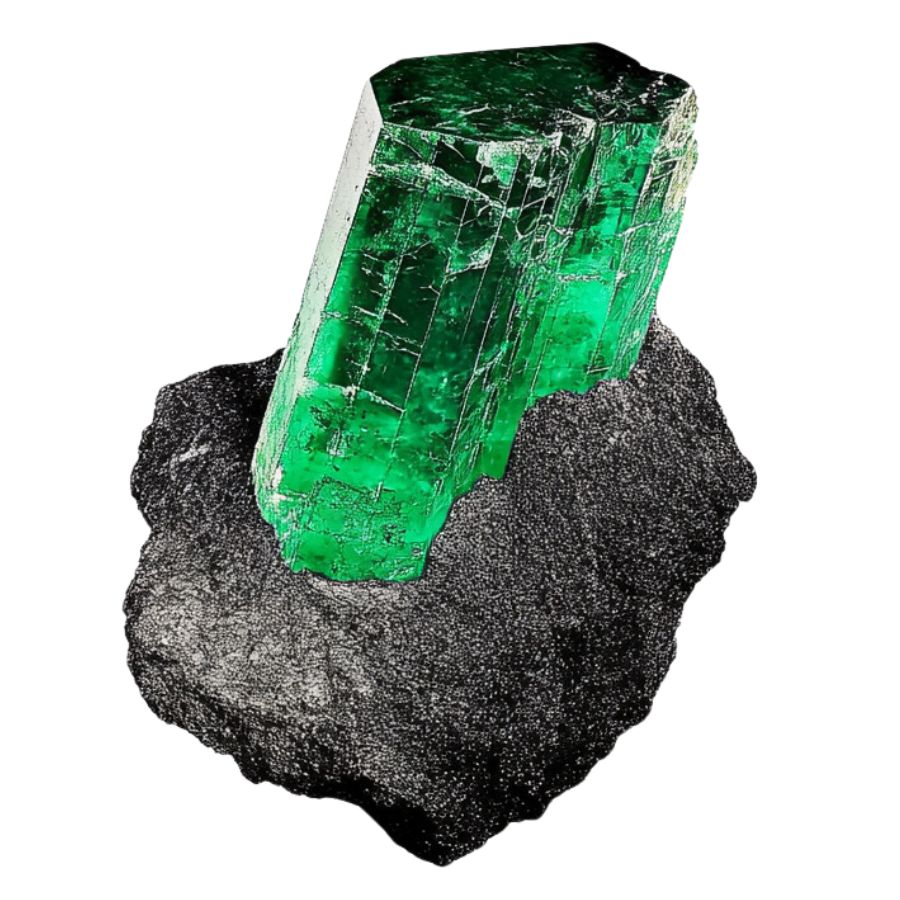
Some crystals are known for their distinct hues, like the deep purple of amethyst or the vibrant green of emerald. However, not all crystals will have strong colors; some may be clear or only slightly tinted.
Check the luster
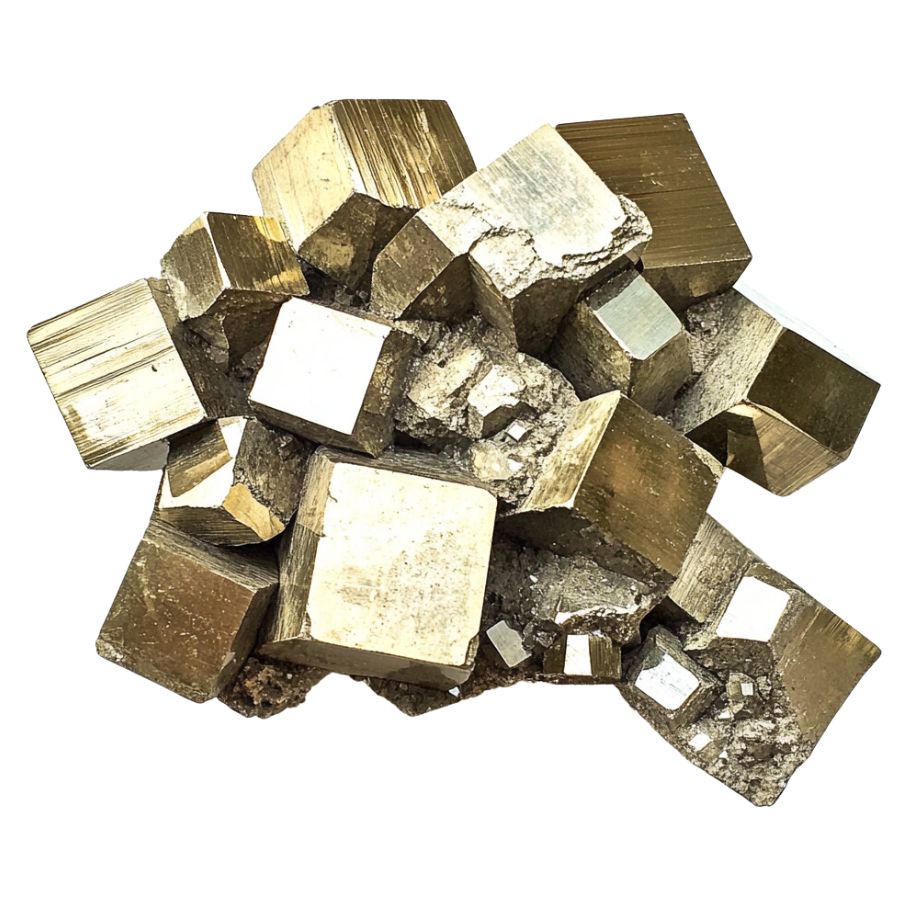
Luster refers to how a crystal’s surface interacts with light. Some crystals might have a shiny, glassy luster, while others may appear metallic or dull. This characteristic can help you determine the type of crystal you’ve found.
However, it’s important to remember that luster isn’t always obvious right away. In some cases, a crystal’s true luster will only become apparent after it’s been cleaned or polished, so keep this in mind as you examine your finds.
Evaluate the transparency
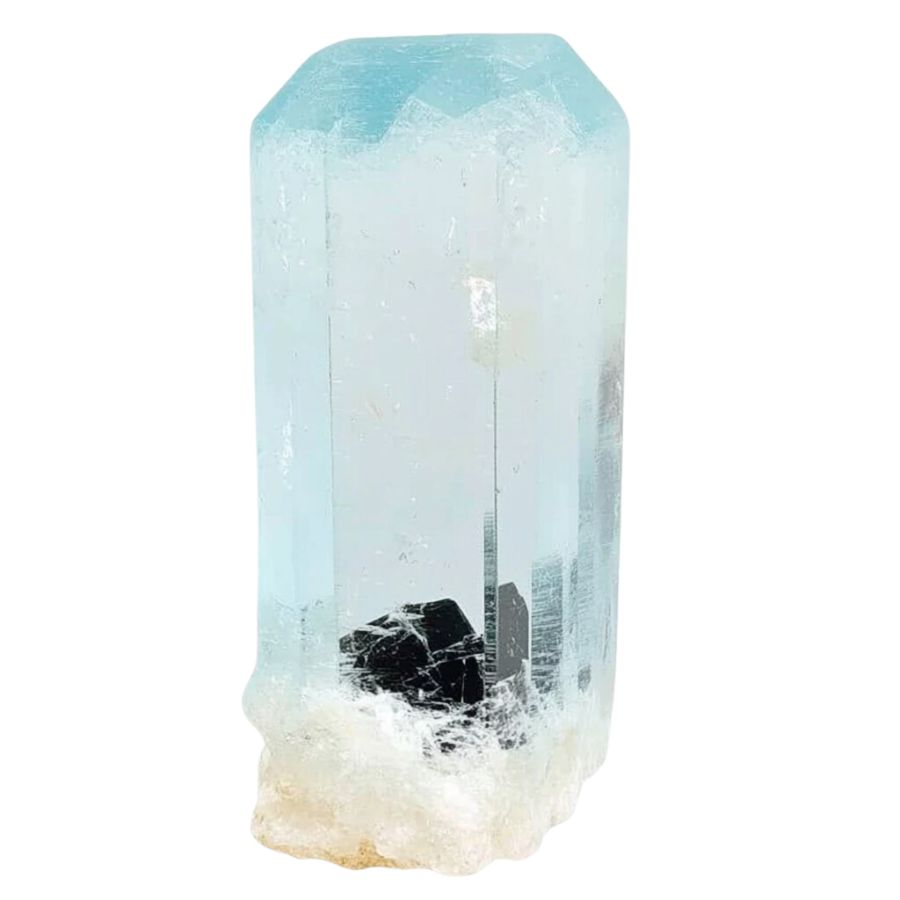
Pay close attention to how much light passes through the crystal. Some crystals are completely clear, allowing light to pass through easily, while others may be opaque and block light entirely.
You might also encounter crystals with translucent edges but opaque centers. These variations in transparency can offer valuable clues about the type of crystal you’ve found, making it easier to identify and appreciate your discovery.
A Quick Request About Collecting
Always Confirm Access and Collection Rules!
Before heading out to any of the locations on our list you need to confirm access requirements and collection rules for both public and private locations directly with the location. We haven’t personally verified every location and the access requirements and collection rules often change without notice.
Many of the locations we mention will not allow collecting but are still great places for those who love to find beautiful rocks and minerals in the wild without keeping them. We also can’t guarantee you will find anything in these locations since they are constantly changing.
Always get updated information directly from the source ahead of time to ensure responsible rockhounding. If you want even more current options it’s always a good idea to contact local rock and mineral clubs and groups
Tips on where to look
Having a better idea of where to look can greatly narrow down your search and increase your chances of finding crystals. By focusing on environments where crystals are likely to be exposed, you can spend less time searching and more time discovering.
Outcrops and Exposed Rock
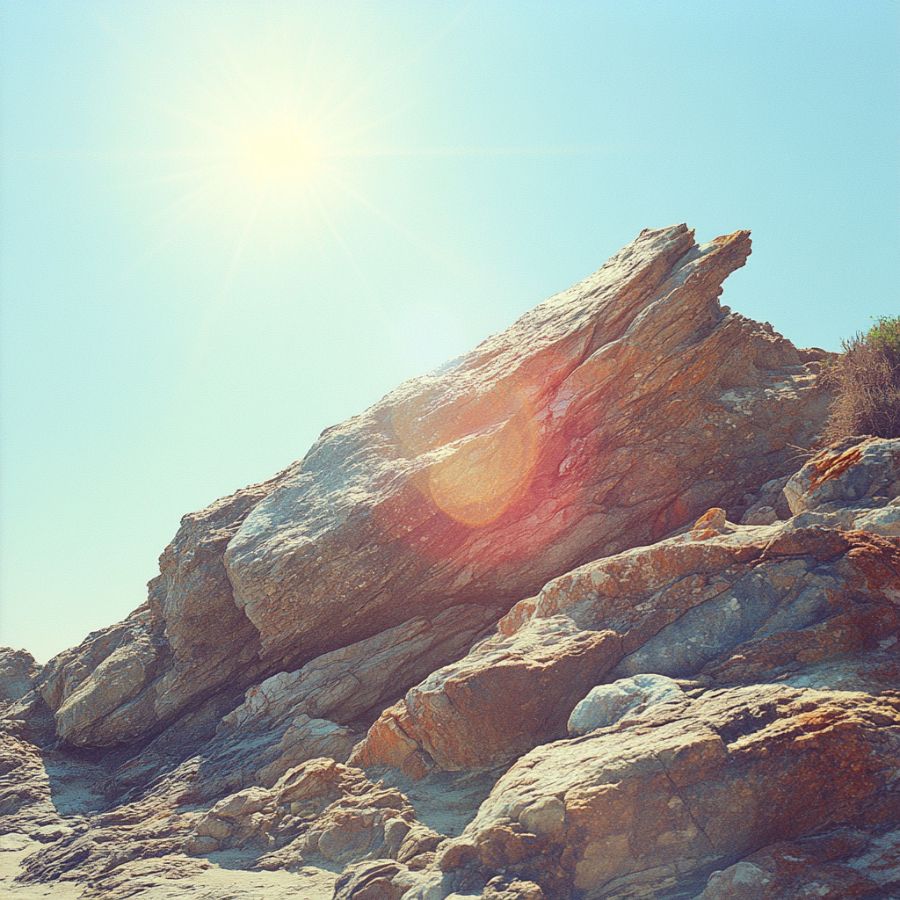
Rocky outcrops are prime locations for finding crystals and minerals. Search along the edges of outcrops, particularly where erosion has worn away the surrounding soil, revealing the rock underneath.
Pay close attention to any visible cracks, crevices, or small cavities within the outcrop, as these are often where crystals develop and can be extracted with minimal effort.
Stream Beds and Gravel Deposits
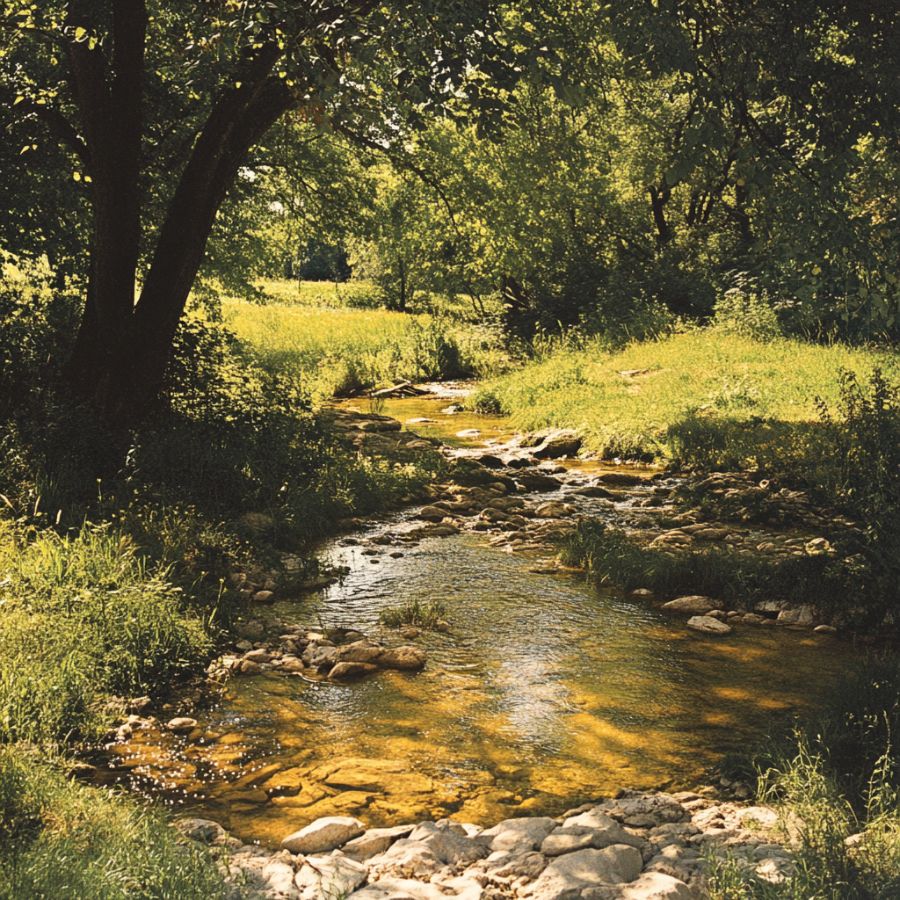
Stream beds are dynamic environments where water flow constantly shapes the landscape. Over time, water can erode rocks upstream, breaking them down and carrying mineral fragments, including crystals, downstream.
When searching in these areas, look for spots where the current has slowed, such as bends in the stream or areas behind large rocks, as these are prime locations for deposits.
Quarries and Mines
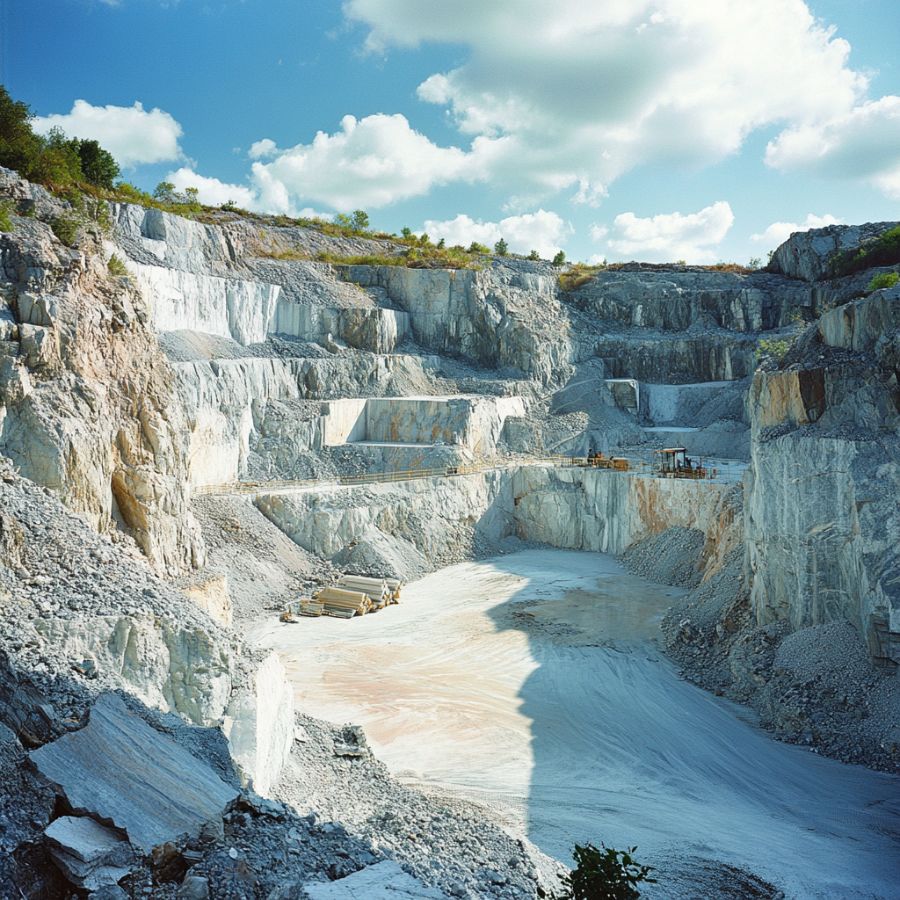
Quarries and mines are excellent places to search for crystals because they expose deep layers of rock that would otherwise be hidden beneath the surface. These sites often contain a variety of minerals and crystals that have been brought to the surface during excavation.
Pay attention to tailings piles, where waste rock is discarded, as they often contain overlooked or broken crystals. Always prioritize safety when exploring these areas and ensure that you have permission to search.
Road Cuts and Construction Sites
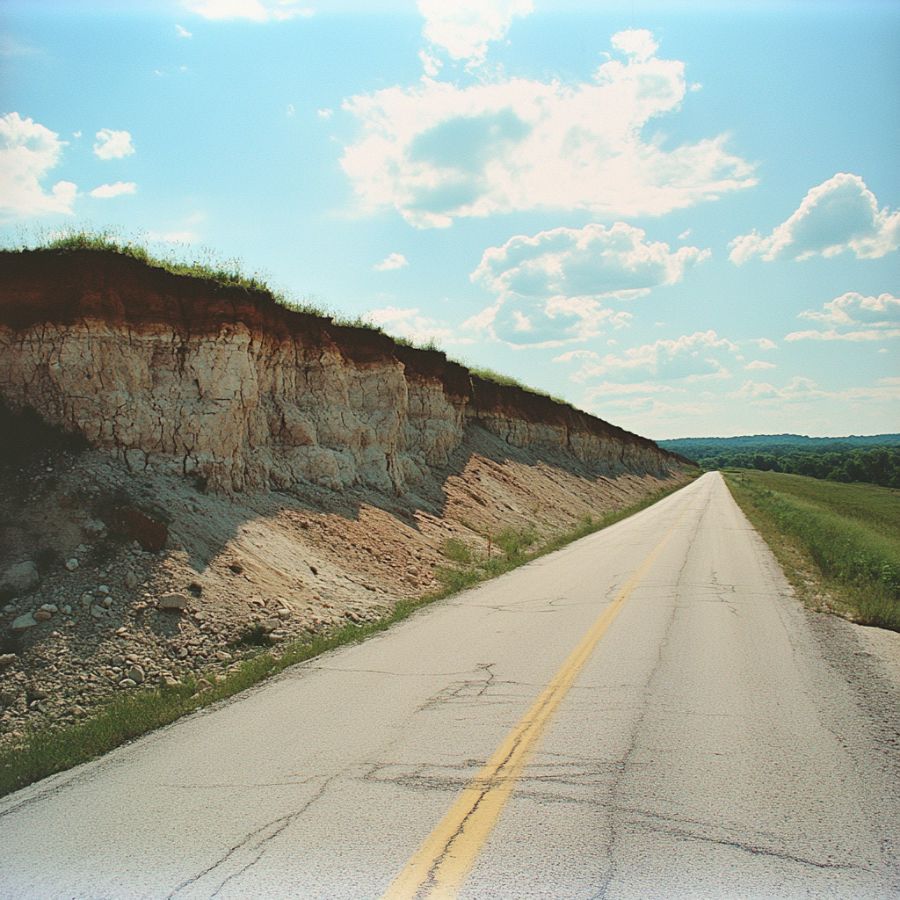
As roads are cut through hillsides or construction projects dig deep foundations, layers of rock and soil that have been undisturbed for millions of years are suddenly exposed.
Look for freshly exposed rock faces, especially where blasting has occurred, as this can create fissures or expose pockets filled with crystals. Be cautious around active construction sites, and always seek permission before exploring.
Mountainous Areas
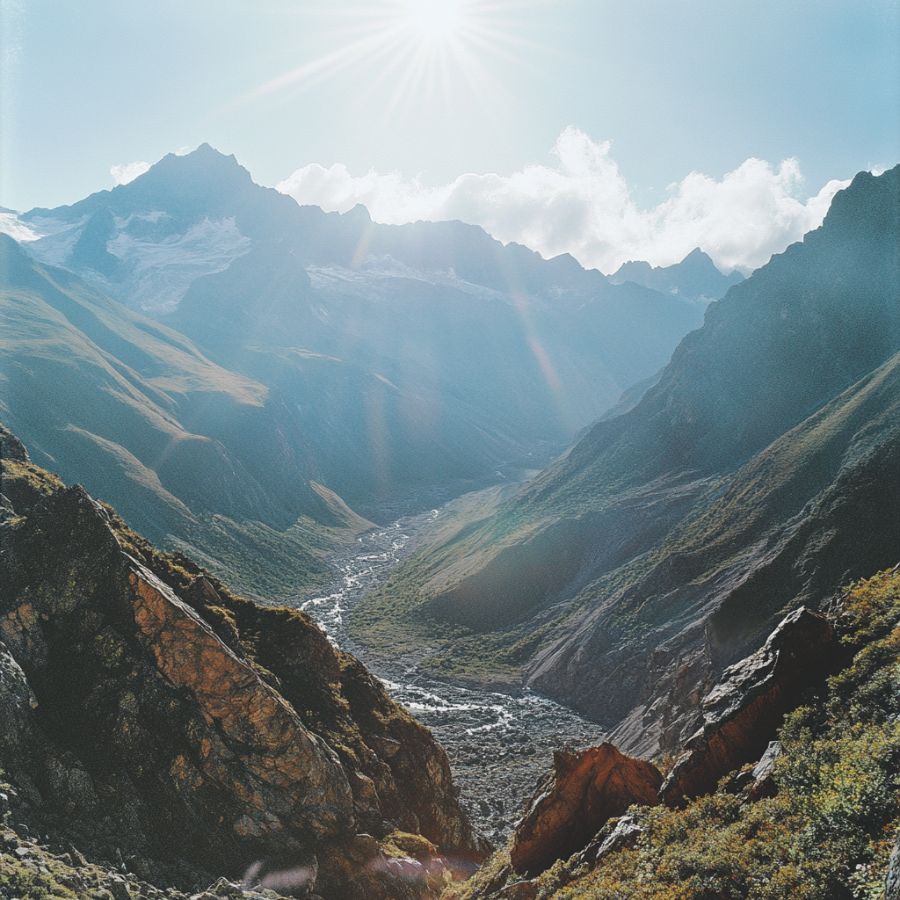
In mountainous regions, erosion caused by wind, rain, and ice can wear away the softer rock, exposing harder crystals that have formed within. Focus on weathered and broken rock formations.
Look for scree slopes, where loose rock has accumulated at the base of cliffs. Additionally, areas near fault lines or volcanic vents are particularly promising, as they often have a higher concentration of minerals.
DON'T MISS OUT ON ANY GREAT FINDS!
While you're out searching for Crystals you're going to find A LOT of other interesting rocks and minerals along the way. The last thing you want to do is toss out something really interesting or valuable. It can be easy to misidentify things without a little guidance.
We've put together a fantastic field guide that makes identifying 140 of the most interesting and valuable rocks and minerals you will find REALLY EASY. It's simple to use, really durable, and will allow you to identify just about any rock and mineral you come across. Make sure you bring it along on your hunt!
Michigan Crystal Mining Laws And Regulations
For as long as you abide by the local collecting laws of Michigan, especially the ones mandated by the Michigan Department of Environment, Great Lakes, and Energy, crystal mining is perfectly legal here.
Primarily, you would need to acquire required permits from concerned government agencies. If you’re exploring private lands, it’s necessary to obtain permission from the owner.
Guidelines to protect the biodiversity of the area may also exist, so make sure you are aware of them. Overall, following these rules and regulations will help ensure the sustainability of crystal hunting in our state for years to come.
- The extensive local experience and understanding of our team
- Input from multiple local crystal hunters and crystal collecting groups
- The accessibility of the crystal mining locations
- Safety and potential hazards when collecting
- Private and public locations
- A desire to include locations for both experienced crystal hunters and those who are just starting out
Using these weights we think we’ve put together the best list out there for those who love finding new crystals for our collections!
The Best Locations For Crystal Mining in Michigan
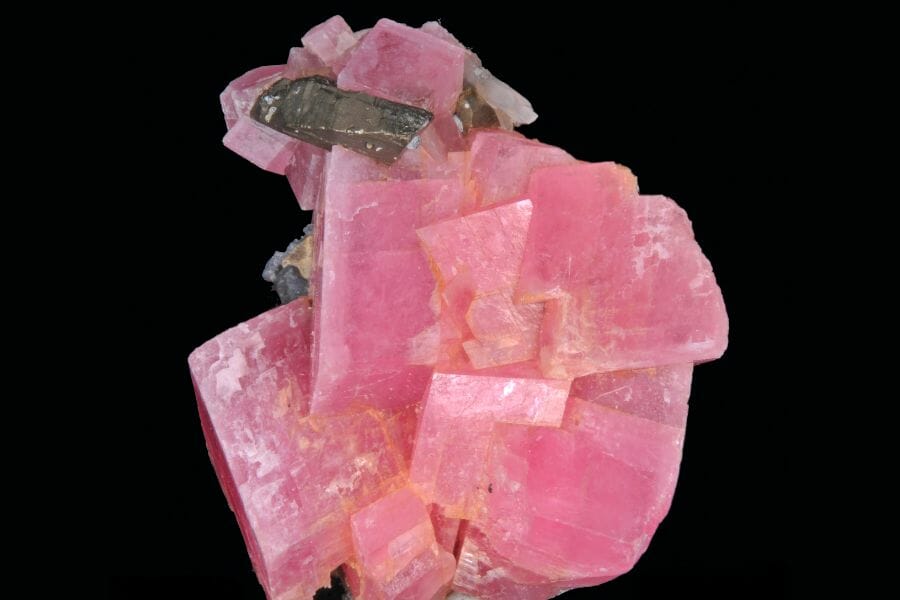
Here are our top recommended places to find crystals in Michigan. We’ve had the best of luck exploring them and finding crystals, and we’re sure you’ll have the same success and fun here, too.
Always Confirm Access and Collection Rules!
Before heading out to any of the locations on our list you need to confirm access requirements and collection rules for both public and private locations directly with the location. We haven’t personally verified every location and the access requirements and collection rules often change without notice.
Many of the locations we mention will not allow collecting but are still great places for those who love to find beautiful rocks and minerals in the wild without keeping them. We also can’t guarantee you will find anything in these locations since they are constantly changing.
Always get updated information directly from the source ahead of time to ensure responsible rockhounding. If you want even more current options it’s always a good idea to contact local rock and mineral clubs and groups
Manitou Island is Our Favorite Crystal Mine in Michigan
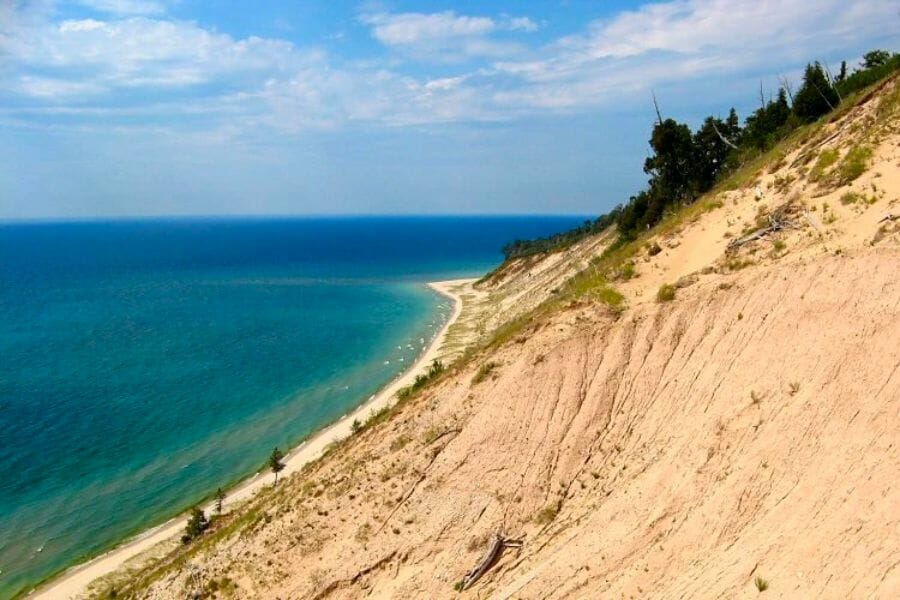
Lake Superior, Keweenaw Peninsula, MI
First and foremost on our recommendation list is Manitou Island, located off the coast of the Leelanau Peninsula. This is a must-visit for anyone looking to add some unique crystals to their collection. If you’re into gems, this is one of the best gem sites in Michigan, too.
Manitou Island has a rich history dating back to the Native American tribes who used the island as a gathering place for hunting and fishing. Today, it’s home to a small community of year-round residents and is a popular destination for hikers, campers, and, of course, rockhounds.
The geography of Manitou Island is breathtaking, with rugged cliffs, pristine beaches, and dense forests covering much of the island. But it’s the geology that really makes this place special, as it’s a treasure trove of unique and rare crystals. The island’s rocky shoreline and exposed bedrock make it an ideal spot for finding crystals, especially after storms when the waves have washed away the sand and revealed new treasures. And while the island’s remote location and limited access make it a bit of a challenge to get to, once you’re there, you’ll find that your effort is well worth it.
Where we found crystals at the Manitou Island
The highly sought-after Lake Superior Agate can be found here. The Manitou Island is just off the east tip of Keweenaw Peninsula. You can explore all beaches surrounding the island, but you should know that the north shore of bays is especially productive with these crystals.
DON'T MISS OUT ON ANY GREAT FINDS!
While you're out searching for Crystals you're going to find A LOT of other interesting rocks and minerals along the way. The last thing you want to do is toss out something really interesting or valuable. It can be easy to misidentify things without a little guidance.
We've put together a fantastic field guide that makes identifying 140 of the most interesting and valuable rocks and minerals you will find REALLY EASY. It's simple to use, really durable, and will allow you to identify just about any rock and mineral you come across. Make sure you bring it along on your hunt!
McLain State Park
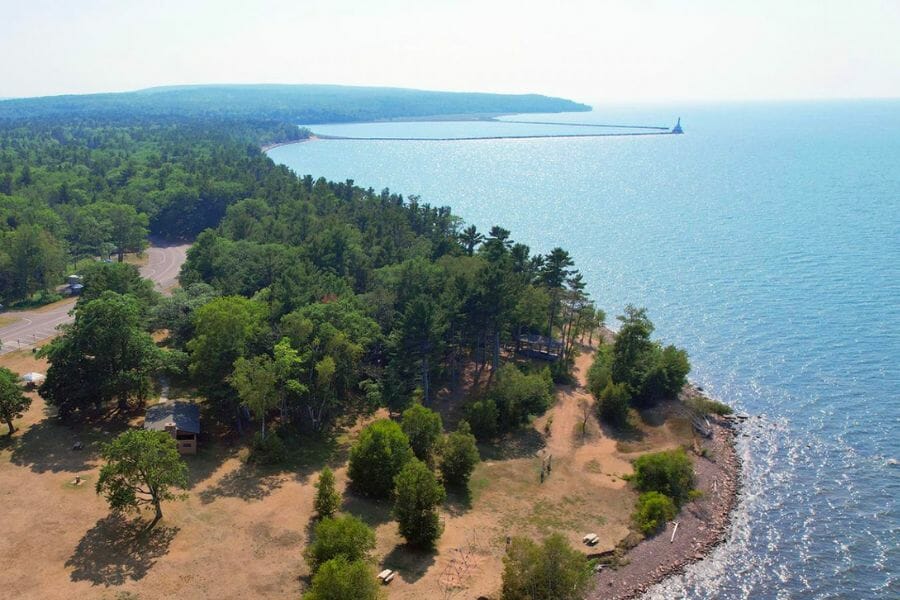
18350 M-203, Hancock, MI 49930
The beautiful McLain State Park is located on the shores of Lake Superior. It’s fascinating history dates back to the 1800s, when it was home to a thriving copper mining industry. The park’s trails and shoreline still bear evidence of this past, with old mining shafts and equipment scattered throughout the area. Today, it’s a popular destination for outdoor activities, including rockhounding.
The park is situated on a rocky outcrop overlooking Lake Superior, with cliffs, boulders, and exposed bedrock covering much of the shoreline. Its rocky shoreline and exposed bedrock make it an ideal spot for crystal hunting, especially after a storm when the waves have washed away the sand and revealed new treasures.
Before you head out to McLain State Park, make sure you come prepared with the right gear and knowledge. Bring sturdy hiking boots, gloves, and a hammer and chisel to help you extract crystals from the rock. And don’t forget to familiarize yourself with the park’s rules and regulations to ensure you’re collecting responsibly and safely.
Where we found crystals at the McLain State Park
Make sure to explore the beaches of the McLain State Park for a better chance of finding Agate, Chalcedony, and Jasper.
Want to know how much crystals cost? Refer to our article on that!
Champion Mine
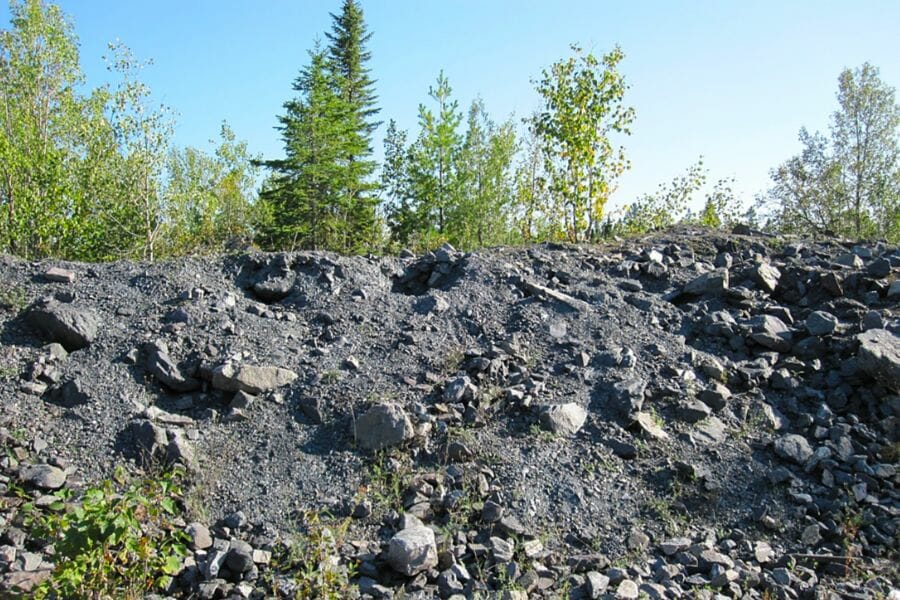
42623 Hubbard Ave. Painesdale, MI 49905
The history of Champion Mine dates back over a century. It was originally established in the late 1800s as a copper mine, but it wasn’t until the 1950s that it became a hotspot for crystal hunters. Today, the mine is no longer in operation, but it’s open to the public for rockhounding and exploration.
The mine is located in the Upper Peninsula of Michigan, near the town of Houghton, and it’s situated on a rocky outcrop overlooking the beautiful Lake Superior. The rock formations in the area are primarily volcanic, which means that there are plenty of unique minerals and crystals to be found.
If you want to visit here, make sure to bring the right gears and be aware that the mine is an old, abandoned structure, so you’ll need to take ample precautions when exploring.
Where we found crystals at Champion Mine
You can find beautiful samples of Hematite and Sapphire crystals if you explore the pegmatite mine dumps of Champion Mine.
Presque Isle County
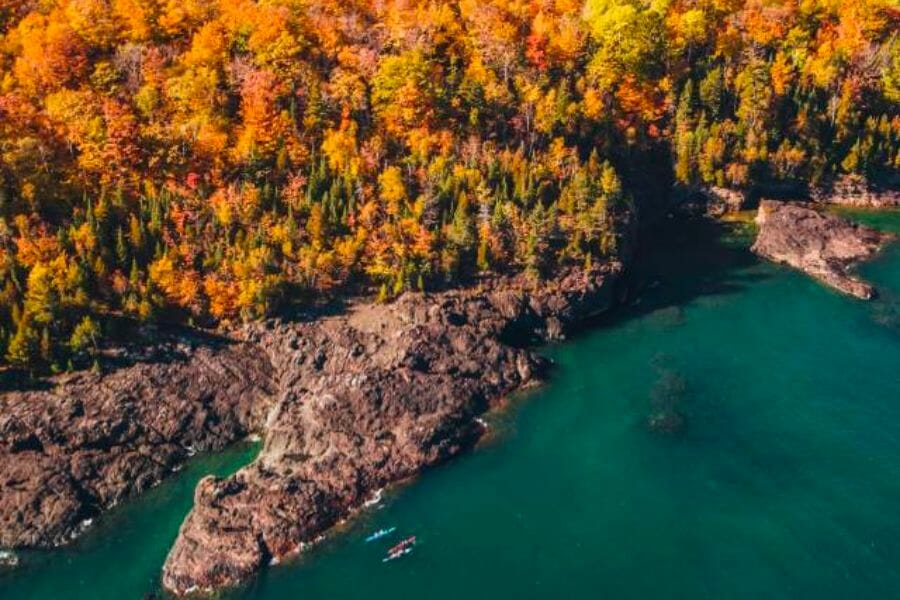
Lake Huron, MI
Presque Isle County is home to a diverse range of geological formations, making it an ideal spot for rockhounding. Located in the northeastern part of Michigan’s Lower Peninsula, this county is rich with a wide variety of rocks and minerals, including some rare and stunning crystals.
One of the most popular spots for crystal hunting here is the Calcite Quarry. This former limestone quarry is now open to the public for rockhounding, and it’s a great place to find calcite crystals in a range of colors, from white to orange and even pink. Another fantastic spot is the Lake Huron shoreline, which is famous for its agate beaches with beautiful translucent agates in shades of red, orange, and brown.
Presque Isle County’s unique geology is due in part to its location on the edge of the Michigan Basin, which is a large geological formation that extends throughout much of the state. The rocks in this area are primarily sedimentary, which means that they’re rich in a wide range of minerals and crystals.
Where we found crystals in Presque Isle County
Exploring this place will allow you to take in the breathtaking sight of the county, particularly its beach gravels, where you can find samples of Agate, Chalcedony, and Calcite crystals.
Ropes Mine
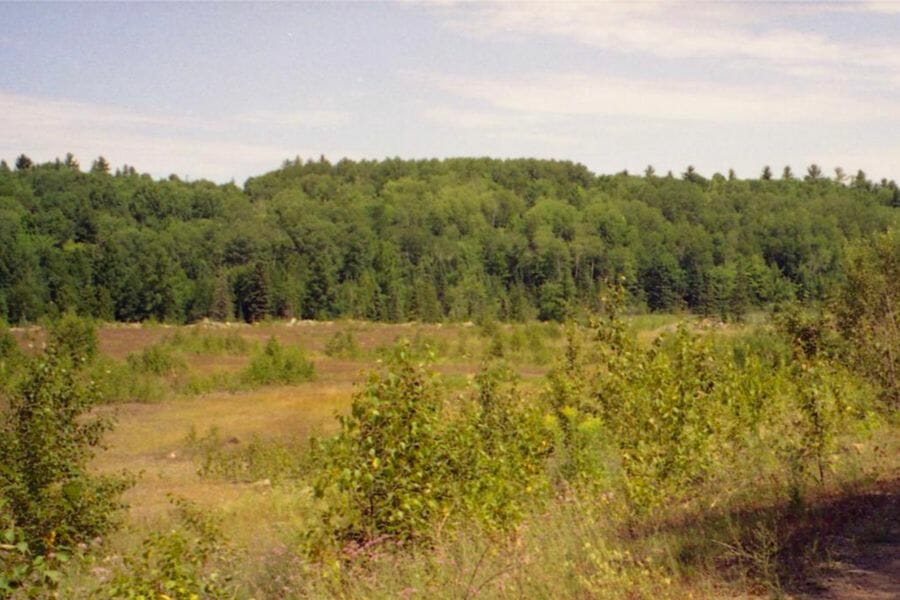
Marquette County, MI
Located in the Upper Peninsula of our state, Ropes Mine was a copper mine that operated from the late 1800s until the early 1900s. This day, it remains a popular destination for rockhounds looking to find crystals in Michigan.
The mine is located in the Keweenaw Peninsula, which is known for its volcanic and sedimentary rocks. The minerals and crystals found in this area are the result of the area’s complex geological history.
One of the most impressive things about Ropes Mine is the variety of minerals and crystals that can be found there. It’s known for producing some truly spectacular specimens, and one of the most sought-after crystals found at the Ropes Mine is copper. These specimens are highly prized by rockhounds and collectors alike for their unique beauty and historical significance.
Where we found crystals at Ropes Mine
We had the best luck finding crystals when we explored the tailing of Ropes Mine.
Our Other Favorite Places For Crystal Hunting
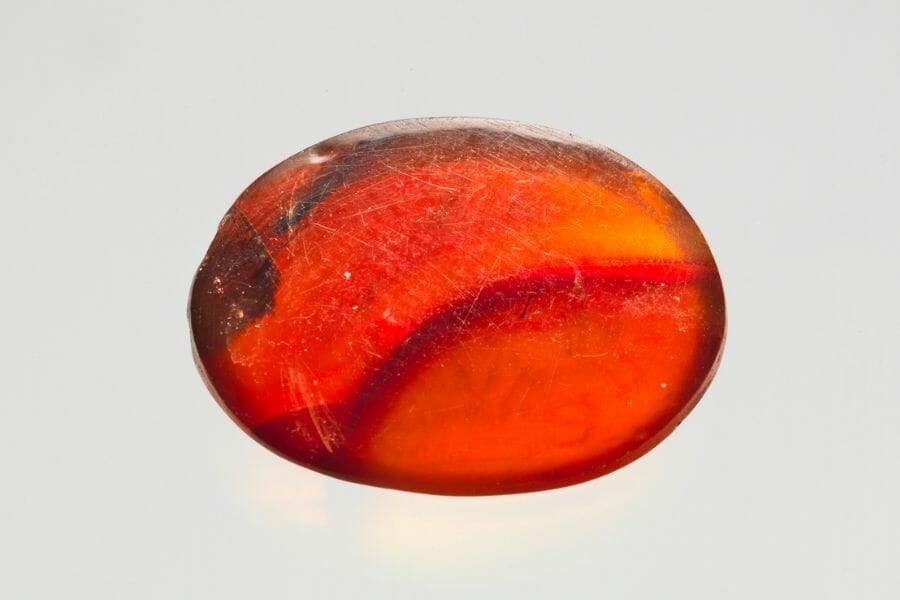
With its interesting geography and geology, it’s no surprise that Michigan has tons of great sites to find crystals as well as to dig for Michigan geodes. Suffice to say, our top recommended places are not the only ones that you can visit. In fact, we’ve listed down some more options that are worth checking out:
Where you can find crystals for free in Michigan
While many of the best places to find crystals here require a certain fee, our state abounds in plenty other locations where you can search and dig for crystals for free.
| County | Location |
| Alger | North shore beaches of Grand Island |
| Alpena | At the Rockport Quarry |
| Charlevoix | Area gravel pits and at the Medusa Quarry |
| Dickinson | Area quarries of Randville |
| Eaton | At the Cheney Quarry |
| Gogebic | Lake Superior Shoreline |
| Isle Royale | Head of Siskowit Bay and on north shore of Tobin Harbor and on adjoining island beaches as well as inland on prehistoric lake beaches from McCargo Cove |
| Keweenaw | On shore and in ledges at the back of Esrey Park |
| Livingston | At the American Aggregate Quarry |
| Luce | West along shoreline of Muskallonge Lake in the Deer Park area |
| Marquette | At Beacon Hill and the abandoned Old Lake Shaft |
| Monroe | At the Scofield Quarry and France Stone Company Quarry |
| Ottawa | 2 miles northwest of Eastmanville area |
| Schoolcraft | Manistique area gravel pits and quarries |
Other great places to dig for crystals
If you’re okay with sparing a dime to find crystals, here are some of the best spots you may want to consider. Take note that their fees might vary, depending on the season, so make sure to reach out to them first before visiting.
| County | Location |
| Houghton | At the Arcadian Mine dump, Quincy Mine dump, and Wolverine Mine dump |
| Iron | All regional iron mines and dumps |
| Keweenaw | At the Allouez Mine, Central Mine dump, Cliff Mine dump, Delaware Mine dump, Mandan Mine dump, Mohawk Mine dump, Phoenix Mine dump, and Star Mine dump |
| Marquette | At the Champion Mine, Archibald Mine, Cliffs Shaft Mine, Section Seven Mine, Holmes Mine, Section Sixteen Mine, Baltic Mine dump, Cambria Mine, and Morris-Lloyd Mine |
| Ontonagon | Area mine dumps of Mass and Rockland areas |
The Best Crystal Shops In Michigan
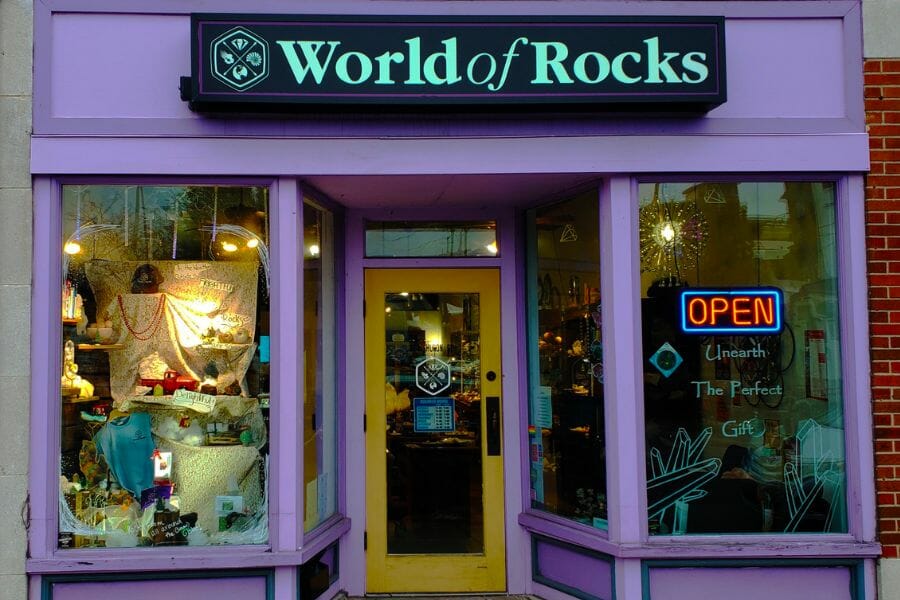
There are so many different types of crystals in the state spread out over such a wide area that many of us like to spend a little money to round out our collections. These are the best crystal shops in California that we’ve found if you’re looking for rare and beautiful pieces for your collection:
- Earth Lore – 895 Wing St, Plymouth, MI 48170
- World of Rocks – 32 N Huron St, Ypsilanti, MI 48197
- Healing Crystals & Stones – 7632 S Westnedge Ave, Portage, MI 49002
- Main Street Rocks and Crystal Shop – 107 Main St, Lake City, MI 49651
- Crystal Treasures – 92 W Walton Blvd, Pontiac, MI 48340
- Orion & The Stone Unicorn – 122 S Otsego Ave, Gaylord, MI 49735
- Rockhound Rock Shop – 33 W Battle Creek St, Galesburg, MI 49053
- The Crystal Cauldron – 1686 E Auburn Rd, Rochester Hills, MI 48307
- Earth Treasures Rocks and Minerals – 6582 Airline Hwy, Fruitport Charter Twp, MI 49415
- Spirit Dreams – 1430 Lake Dr SE, Grand Rapids, MI 49506
Additional places to find crystals in nearby states
If you’ve already tried all of our recommendations above or are planning a trip out of the state, you should check out our guides for neighboring states:
If you have any recommendations we haven’t covered, please leave them in the comments below!

